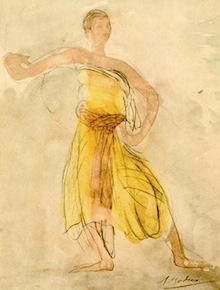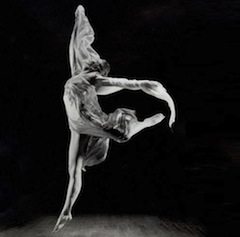
“We’re inviting Rodin to be our teacher. What can we learn?” Muriel Maffre, ballerina turned curator, was asking her dance class in Stanford University’s Cantor Art Center auditorium.
Plenty, and a fair exchange. Auguste Rodin (1840–1917), after all, learned from dancers, beginning with the scarf-swirling Loie Fuller, but most notably from Isadora Duncan, the California iconoclast and mother of modern dance.
That learning and teaching motivates Rodin and the Dancing Body, which Maffre coordinated, one of the topics of the museum’s current exhibit, “Rodin: Influence and Adaptation 1876–1936,” which ends Jan. 1. To the Cantor’s Rodin collection — one of the largest outside of Paris — has been added extra dazzlement: dozens of works created by Rodin and artists he influenced and inspired, borrowed from collections all over the U.S.
Maffre’s studio class, which the public may watch in process in the Cantor’s first-floor auditorium, adjacent to the main exhibit space, explores the connection between dance and Rodin, her countryman. It continues this month and next, ending with a showcase Dec. 3 at Stanford’s Roble Gym. Noted Bay Area choreographer Alonzo King, whose LINES Ballet/Dominican University B.F.A. students are participating alongside Stanford dance students, is also taking part, teaching portions of his 1990 ballet Without Wax, which connects to Rodin’s lost wax–casting methods.
Maffre’s class is about “finding a way to tune in to who they are as artists, who they are as creative people,” she said. “I’m trying to give them tools and skills. I invited student dancers and student nondancers. I’m trying to get away from the obsession with technique and practicing steps, and get away from the preconceived idea that ballet embodies Western values.” She also gives the class permission “to be curious, to be irreverent. Any exploration is valid.”
Intertwined Experiences
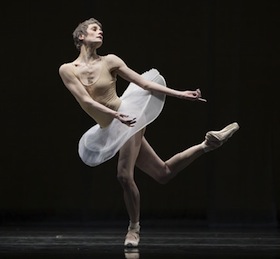
Cantor visitors are invited to roost on stools to watch the dancing and to sketch their impressions. Upstairs, in the Lynn Krywick Gibbons Gallery, the walls are covered with white paper. There’s an installation of the only surviving film of Isadora Duncan, dancing at a garden party (30 seconds long, it’s also on YouTube). Visitors with drawing materials move as the film inspires them to, and the rhythms and the lines go on the paper. Also showing upstairs is a green-screen film superimposing the dance students with Duncan at that garden party. The filmmaker is Maffre’s husband, Benjamin Pierce, formerly her partner at San Francisco Ballet, now a videographer.
The archival film clip fascinates Maffre. “It’s an amazing, magical moment. It’s the only thing where we can see her in person,” she said. “Not only as a performance, but looking at the people who are watching her. It talks about the art at that time. The female figure is always the one that is looked at. Sometimes it’s great,” she said, and then laughed, adding “sometimes not so great. There are mainly men in the audience looking at her, looking at this libertine woman dancing. It’s an experience, to appreciate it from her point of view.”
Maffre’s work on the Rodin project is part of what she describes as “an attempt to reconcile a great love for ballet, and being at odds with what it represents,” including, she said, outdated notions of imperialism, courtly manners, societal hierarchies, and male dominance. Her challenge, she said, is “How can you look at it in a different way?”
“I’m trying to get away from the obsession with technique and practicing steps, and get away from the preconceived idea that ballet embodies Western values.” – Muriel Maffre
Maffre studied at the Paris Opera Ballet School and danced with both the Hamburg Ballet and Les Ballets de Monte-Carlo before joining the San Francisco Ballet in 1990 as one of its most compelling principal dancers. In 2007, at the apex of her career, she retired. Maffre had earned her bachelor’s degree while she was dancing at SFB. After her retirement, she earned a master’s degree in museum studies at John F. Kennedy University in Berkeley, with a long-range goal of exploring the connection between the visual and performing arts. Despite the impressive amount of research she’s brought to the Rodin project, Maffre demurred, “I’m not a Duncan expert. My expertise is in movement and music education.”
Learning to Capture Natural Movement
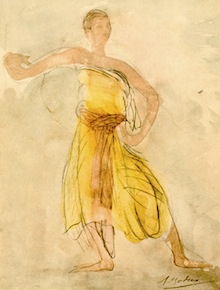
Image ©Philadelphia Museum of Art/Art Resource, NY.
Maffre and her students have read and discussed Rodin’s thoughts on dance and its relationship to sculpture, Duncan’s ideas on movement, and other commentary. Working with photographs and texts as well as that snippet of film, they’ve emulated Duncan’s choreography, tried it on their bodies. They can appreciate what the art critic Yvanhoe Rambosson wrote in 1900:
There is perhaps nothing more difficult for an artist than to train his eyes to capture real movements in their complexity. ... A true gesture ... how many could one find in the history of art? Maybe 10? Maybe 20? The artwork in which there is one is assured not to perish. ... I think amongst Rodin’s creation ... ‘The Burghers of Calais’ and the formidable ‘Balzac,’ which is in its entirety a gesture.
And this, from Duncan:
It is in nature alone that the dancer has to draw his inspiration, as well as the sculptor, with whom he has much affinity. It is Rodin who says: ‘To make sculpture, one cannot copy the works from antiquity; one has to look at the ones in nature and to only see in the works of antiquity the way nature was interpreted.’
Maffre’s students read excerpts from a 1911 issue of the French magazine l’Oeuvre, dedicated to Duncan:
Isadora Duncan arrived to sculpture, to emotion, without effort, we could say. ... She makes dance attuned to line and she is unaffected, like a classic antiquity, which is a synonym of beauty. Suppleness, emotion, these great qualities which are the soul of dance itself: it is art complete and free. — A. Rodin
In the auditorium with a dozen dance students on a recent afternoon, as an equal number of sketchers watched from the sidelines, Maffre said, “I’m going to ask you to quiet the mind, slow down. We’re going to go through some stretches, focus on the curvature of the torso, go into walking and falling.” The dancers, in practice clothes and soft slippers, began to stretch as if awakening, making their bodies look sleepy and pliant. They stretched like cats on all fours, rising until they were almost standing, then falling.
“Each gesture has a single focus, a single motivation.” – Maffre
Maffre brought out some simple shirts, as might have been worn by French peasants in the 1800s. She asked the class to “play with the idea of hiding the face, and revealing the face.” The shirts became scarves, veils, bindings, frames. “Find a dynamic stillness in your phrasing,” Maffre urged, as the onlookers sketched raptly. “This is really your own exploration. I’m giving you a tool. Sustain the exploration, so we have a dance to go with you on that journey.” The dancers went into slow-motion mode.
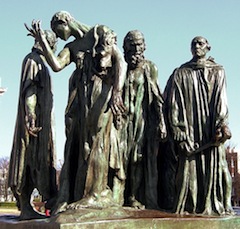
Then Maffre brought out photos of Rodin’s Burghers of Calais for them to emulate, “to get the poses into the body.” She explained how they could use walking as a support for the gestures they wanted to make. “Each gesture has a single focus, a single motivation.” More exercises followed: falling, where one dancer was caught by the others in the group; morphing, where the group, as one, changed its gestures with great subtlety.
Finally, at the end of the class, Maffre asked the students to incorporate everything they’d worked on for the past two hours.
She outlined it, they asked a few questions, and, to Ravel’s Bolero, out of the gestures, the work, the spirit of what they’d been doing, they made a dance. In the words of Rodin, “Modeling and movement are like the breath and blood of all beautiful artwork.”

